10 Days Eastern Tibet Photography Tour

Tour Overview
The beauty of Nyingchi is proudly compared to that of Switzerland. This 10 days eastern Tibet photography tour is a classic photography tour with high accessibility, covering tour to snow-capped...
Code of Tour: YCT0000004701
Length of Travel: 10 Day
Destinations of Tour: Nyingchi-Bomi-Ranwo-Lhasa
Departure City: Lhasa
Price of Tour: Request
Type of Tour:
Features of Tour: Photo Culture History Minority
The beauty of Nyingchi is proudly compared to that of Switzerland. This 10 days eastern Tibet photography tour is a classic photography tour with high accessibility, covering tour to snow-capped mountains, glaciers, and lakes, grassland and wild flowers, villages and farmlands, which makes Nyingchi a major draw for numerous photographers both home and abroad. The highlights and attractions in this tour are highly representative.
Highlights
- Shoot at the beautiful places in Tibet.
- Enjoy the spectacular view and do sightseeing in Tibet.
Brief Itinerary
- Day 1 Arrive in Nyingchi Airport
- Day 2 Nyingchi-Bomi
- Day 3 Bomi-Rawo
- Day 4 Rawo-Nyingchi
- Day 5 Nyingchi-Lhasa
- Day 6 Lhasa
- Day 7 Lhasa
- Day 8 Lhasa-Lake Namtso
- Day 9 Lake Namtso-Lhasa
- Day 10 Lhasa Departure
Google Map
Detailed Itinerary
Day 1 Arrived at Nyingchi Airport (3100m)
Sightseeing and Activities:None
Accommodation:
Meals:
Upon you arrival in Nyingtri by flight, our local tour guide will welcome you at the airport, transfer to hotel by private car.
Stay overnight in Nyingtri.
Day 2 Nyingchi (3100m) to Bomi (2750m)
Sightseeing and Activities:Cypress tree, Mt. Sekyim la, View of Namcha Barwa, and Lulang Forest
Accommodation:
Meals:
Today, firstly we are about to visit the Great Cypress Nature Reserve area, which is 15 kilometers southeast of the Bayi Town, The king cypress in the reserve is about 50 meters tall and is about 2,500 years old.
Then we will drive to Sekyim la Pass (4720m) and enjoy the great Mt. Namjia Bawa (7,700m) in the distance. Then, continue to drive to the bushy Lunang Forest with an elevation of 3700m, and it is a typical highland meadow strip, and both sides of Castle Peak from low to high from the dense bushes, spruce trees and pine. The distant clouds, the snow-capped mountains, the endless pines and the quiet pastoral displayed a beautiful landscape.
Then we will reach Bomi.
Stay overnight in Bomi.
Day 3 Bomi to Rawo (3900m)
Sightseeing and Activities:Midui Glacier, Ranwu Lake
Accommodation:
Meals:
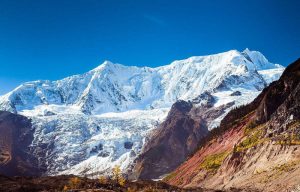
In the morning, we will set off to our destination today- Ranwu Lake.
On the way, we stop at Midui Village to visit Midui Glacier famed as the most beautiful glacier in China. Midui Glacier was converged by two ice falls, and there were primitive forests between the two ice falls.
Then we continue heading to the Rawo Lake, which is situated at the southwest 89km Basu County. Rawok Lake is the main headstream of the Yarlung Tsangpo River confluent. The snow-capped mountains, forests, and lakes are all combined together here to make it beautiful as paradise.
Stay overnight in Rawo.
Day 4 Enjoy the Sunrise of Ranwu Lake and Drive to Nyingchi (3100m) from Rawo
Sightseeing and Activities:sunrise of Ranwu Lake, Sightseeing on the way
Accommodation:
Meals:
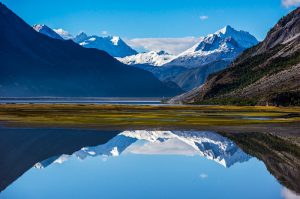
We will get up early today to enjoy the sunrise of Ranwu Lake. After taking photos here at Ranwu lake, we will drive back to Pome via G318 China National Highway.
From Rawu to Palongzangbu of Bomi, it’s one of the most beautiful parts of Sichuan-Tibet overland road. We recommend you to stop on the way frequently to take pictures, because there are snow-capped mountains, forests and lakes along the way.
Then drive back to Nyingchi (Bayi) town. Today’s itinerary involves around 8-9 hours driving, do have a nice sleep before.
Stay overnight in Nyingchi.
Day 5 Enjoy the Natural Scenery along Niyang River from Nyingchi to Lhasa(3650m)
Sightseeing and Activities:Niyang River
Accommodation:
Meals:
Today we will drive back to Holy City Lhasa along the beautiful Niyang River, a major river in southeast Tibet and the longest tributary of Yarlung Tsangpo River. You can see grand and superb natural scenery on the way back.
Stay overnight in Lhasa.
Day 6 Lhasa
Sightseeing and Activities:Potala palace, Jokhang Temple and Barkhor Street
Accommodation:
Meals:
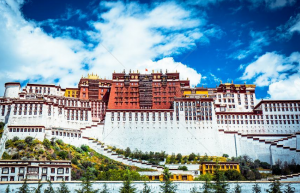
Today’s tour will first bring you to the Potala Palace, the winter palace of the Dalai Lama. It has been used since the 7th Century by the 33rd great king of Tibet. The most valuable collections are the gilded burial stupas of past Dalai Lamas and meditation Cave of the 33rd great king of Tibet.
After you take lunch and then head to Jokhang Temple which was founded by the 33rd great king of Tibet in the 7th century, in order to promote the Buddhist religion. Inside you can see the statue of Buddha Sakyamuni at the age of twelve, perhaps the single most venerated object in Tibet Buddhism. Around the temple Barkhor Street where you can do kora (circling the Barkhor street) with pilgrims and locals and buy the souvenirs.
Stay overnight in Lhasa.
Day 7 Lhasa
Sightseeing and Activities:Drepung Monastery and Sera Monastery
Accommodation:
Meals:
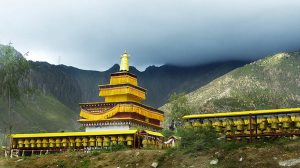
In the morning, you are going to visit Drepung Monastery which was one of the “ three greet” Gelug monasteries of Tibet and was founded in 1416 by Jamyang choge, one of the Tsongkhapa’s main disciples. Ganden palace is used as Dalai lama’s palace in the Drepung before moving to the Potala palace.
Afternoon, Sera Monastery—It was one of the “three great” Gelug monasteries of Tibet and was founded in 1419 by Jamchen Chojey, one of the Tsongkhapa’s main disciples. The highlight is the Monks debate at around 3 – 5 in the afternoon.
Stay overnight in Lhasa.
Day 8 Lhasa (3650m) to Lake Namtso (4718m) via Nyenchen Thanglha Range
Sightseeing and Activities:Lake Namtso, Nyenchen Thanglha
Accommodation:
Meals:
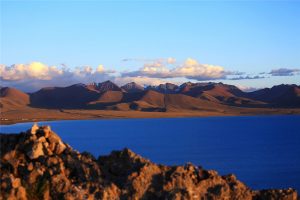
In the morning, drive from Lhasa to Lake Namtso. On the way, you can see Nyenchen Thanglha ( snow mountain ranges )and lots of nomads tent with grazing yak and sheep densely-populated around the mountain side.
Namtso Lake is the Heavenly lake which is one of the four holy lakes of Tibet and also the highest salt lake. You can do a very relaxing trekking around the lake side and Tashi Island. To spend a night at lake shore is fantastic to see the stars.
Stay overnight in Namtso Guest House.
Day 9 Lake Namtso (4718m) to Lhasa (3650m)
Sightseeing and Activities:Lake Namtso, Yangpachen hot spring
Accommodation:
Meals:
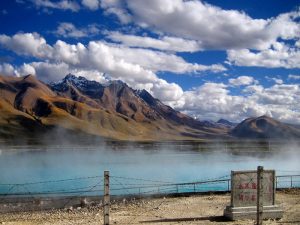
Enjoy the clear morning at the lake shore, you can trek along the lake shore to Tashi Dor Island to explore the meditation caves. Drive to Dumxung to have lunch.
In the afternoon, you may enjoy Yangpachen Hot Spring (Optional) and have both indoor and outdoor swimming pool filled with hot springs water.
Finally head back to Lhasa.
Stay overnight in Lhasa.
Day 10 Depart from Lhasa
Sightseeing and Activities:Depart from Lhasa
Accommodation:
Meals:
You will be transferred to the airport for your departure flight to next destination.
Recommended Hotels
| City | 5 Star | 4 Star | 3 Star |
|---|---|---|---|
| Nyingchi | / | Nyingchi Shangbala Hotel | Fujian Hotel in Nyingchi |
| Bomi | / | Bomi Pingcuo Kangsang Holiday Hotel | Tianma Hotel |
| Ranwo | / | / | Ranwo Guesthouse |
| Lhasa | Luxury St. Regis Lhasa Resort | Lhasa Gang Gyan Hotel | Lhasa Xiongbala Hotel |
| Namtso | / | / | Namtso Guesthouse |
Quotations
| Group size(person) | 5 Star ($) | 4 Star ($) | 3 Star ($) |
|---|
Service Included:
-
Tibet travel permit and all other necessary permits to Tibet;
-
All entrance ticket fees for all tourist sites listed in the itinerary;
-
Personal knowledgeable English-speaking Tibetan local tour guide;
-
Personal comfortable, clean and safe vehicle with reliable Tibetan local driver; vehicle ranging from 4WD land cruiser to minibus depending on your group size;
-
All lodging listed in the itinerary; it’s your decision about the accommodation class: luxury 5-star international hotel, comfortable 4-star hotel, economic 3-star hotel or budget hostel, guesthouse or tent. Please tell us your accommodation preference when submitting the enquiry; we will arrange the best-value hotels for you.
-
Domestic flight/train tickets listed in the itinerary;
-
All meals listed in the above itinerary;
-
Tourist accident/casualty insurance;
-
First aid kit;
Service Excluded:
-
International flight to and out of China;
-
Chinese visa (Note: we could help you with the Chinese visa application, like providing the invitation letter, presenting the hotel or domestic flight reservation copies, etc that you may need. )
-
Domestic flight/train not listed in the itinerary. (We can provide you the domestic flight/train ticket booking service at the BEST discount price; please contact us our travel experts for the details.)
-
Meals not specified in the itinerary; usually it costs about USD3-15 per person for one meal in TAR (Tibet Autonomous Region).
-
Tips and gratitude to tour guide and driver;
-
Personal expenses, like laundry, phone call, snacks, soft drinks (please do the best to avoid the alcoholic beverages during your Tibet trip), optional tour activities, etc.
Travel Tips:
1. What Are the Features of Our Group Tours
Our Group Tours are budget tour packages with great service which have covered the most popular destinations in Tibet with reasonable trip lengths. Joining in our group tours, you will choose your travel dates from our fixed departures and travel in a small group with maximum members of 12 people.
2. Tibet Permits
There are several permits required to visit Tibet. Tibet Entry Permit, issued by Tibet Tourism Bureau, is the most important one which has to be obtained before your trip because you must have it to take your flight/train to Tibet. To get the permit, you have to book a Tibet tour with us, and send us your passport and Chinese visa about 20 days in advance, and then let us apply for the permit (all Tibet permits can only be applied by travel agency). If you travel to other prefectures like Shigatse, Nyingchi, Shannan, etc, you also have to obtain an Alien Travel Permit. If you travel to Mount Everest, you have to obtain a Border Permit. (Tibet Discovery, with office in Lhasa, has always kept up with the latest news on Tibet Permits. Traveling with us, all your permits are guaranteed as long as you are qualified to the requirements.)
3. Available Months to Visit Tibet
Generally speaking, you can travel to Lhasa all year around. But months from April to October are more recommended. If you want to extend your trip to other regions, such as Shigatse, Mount Everest, Namtso, Ngari, etc, you are suggested to visit during April to October. Other months are usually very cold, and possible have heavy snow, especially in regions like Mount Everest, Mount Kailash, Namtso Lake, etc.
4. High Altitude Sickness
The average altitude of Tibet is about 4000 meters above the sea level (Lhasa: 3700m; EBC: 5200m; Namtso: 4718m). You may suffer a bit from High Altitude Sickness in the beginning days of your Tibet trip if you haven’t had rich high plateau travel experience. But don’t worry too much, the high altitude can be acclimatized usually in 2~3 days. Our suggestion is to take a physical examination and get suggestions from your doctor, and also bring some medicines to prevent from High Altitude Sickness before your trip. While in Tibet, you should keep warm all the time, avoid strenuous activities, drink more water and eat more vegetables and carbohydrates. You’d better not take showers during the first two days after your arrival at Tibet. If you don’t feel well, get help from your tour guide or go to the hospital without any delay.
5. How to Go to Tibet
Basically you have two options – flight and train. Currently, you can take a flight to Lhasa from Beijing(4.5hrs), Xian(3.7hrs), Chengdu(2.5hrs), Chongqing(3hrs), Kuming(3hrs), etc. Among all these cities, Chengdu and Xian have more frequent flights to Lhasa. You can also fly to Lhasa from Kathmandu(1.5hrs) .Xian(32hrs), Chengdu(43hrs), Shanghai(47hrs), Chongqing(42hrs), Lanzhou(25hrs), Xining(22hrs), Guangzhou(54hrs).
6. Packing and Wearing Ideas
Firstly you can’t forget your passport and Chinese Visa. A large backpack and a smaller one are recommended (the smaller one can be used for daily activities). Also bring the necessary medicine you need. Other stuffs like sunglasses, snow glasses, hats, lip balm, sun block are recommended.
As for wearing, you are suggested to dress in layers (both thin and thick jackets). Down jacket is necessary in Spring and Autumn. A pair of durable and comfortable shoes is necessary.

















